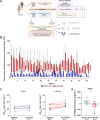Exercise Training Reduces the Inflammatory Response and Promotes Intestinal Mucosa-Associated Immunity in Lynch Syndrome
- PMID: 37724990
- PMCID: PMC10618653
- DOI: 10.1158/1078-0432.CCR-23-0088
Exercise Training Reduces the Inflammatory Response and Promotes Intestinal Mucosa-Associated Immunity in Lynch Syndrome
Abstract
Purpose: Lynch syndrome (LS) is a hereditary condition with a high lifetime risk of colorectal and endometrial cancers. Exercise is a non-pharmacologic intervention to reduce cancer risk, though its impact on patients with LS has not been prospectively studied. Here, we evaluated the impact of a 12-month aerobic exercise cycling intervention in the biology of the immune system in LS carriers.
Patients and methods: To address this, we enrolled 21 patients with LS onto a non-randomized, sequential intervention assignation, clinical trial to assess the effect of a 12-month exercise program that included cycling classes 3 times weekly for 45 minutes versus usual care with a one-time exercise counseling session as control. We analyzed the effects of exercise on cardiorespiratory fitness, circulating, and colorectal-tissue biomarkers using metabolomics, gene expression by bulk mRNA sequencing, and spatial transcriptomics by NanoString GeoMx.
Results: We observed a significant increase in oxygen consumption (VO2peak) as a primary outcome of the exercise and a decrease in inflammatory markers (prostaglandin E) in colon and blood as the secondary outcomes in the exercise versus usual care group. Gene expression profiling and spatial transcriptomics on available colon biopsies revealed an increase in the colonic mucosa levels of natural killer and CD8+ T cells in the exercise group that were further confirmed by IHC studies.
Conclusions: Together these data have important implications for cancer interception in LS, and document for the first-time biological effects of exercise in the immune system of a target organ in patients at-risk for cancer.
©2023 The Authors; Published by the American Association for Cancer Research.
Figures




References
Publication types
MeSH terms
Grants and funding
LinkOut - more resources
Full Text Sources
Molecular Biology Databases
Research Materials

